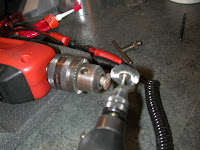

A very hot car!
In fact a little bit too hot for my taste.... it almost burnt down today! Just at noon when I was heating up my lunch in the microwave, my phone rang and my brother (he's a fireman) told me to look for my car because there was a fire in the garage where I parked it.
When I arrived there, the road was already blocked with firetrucks and hoses and police cars, firemen (and women) running around and the wole area smelled like burning plastic. Smoke came out of all openings of the garage.
I tought "well, there is not much to do at the moment" and I waited there and looked what's happening. About one hour later, when the firemen cleared up their equipment and the police had finished investigating, I was allowed to enter the garage for a look.
What can I say... everything was completely black. Even the light from the few remaining lamps on the ceiling seemed to be black. In fact the lamps have also been blackened by the huge amount of smoke.
What I saw was that my car was still there, on it's wheels and it seemed to be more or less ok. In fact it suffered amazingly little damage despite the fact that the fire was on the parking field directly next to it.
It was not a car that burned but some stuff from the janitor who stored his tools and stuff down there. I don't know how the fire started, that's what the police will try to find out now.
It took almost an hour to wash all the dirt from my car. There have also been some drops of molten plastic on it's backside. It must have been really hot there.
Well... it seems my car needs a new painting as you can see on the pictures and I need a good meal and some rest now. That was an exciting day...!

















































